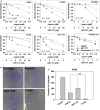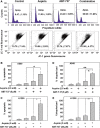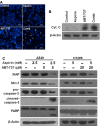Role of p38 MAPK in enhanced human cancer cells killing by the combination of aspirin and ABT-737
- PMID: 25388762
- PMCID: PMC4407609
- DOI: 10.1111/jcmm.12461
Role of p38 MAPK in enhanced human cancer cells killing by the combination of aspirin and ABT-737
Abstract
Regular use of aspirin after diagnosis is associated with longer survival among patients with mutated-PIK3CA colorectal cancer, but not among patients with wild-type PIK3CA cancer. In this study, we showed that clinically achievable concentrations of aspirin and ABT-737 in combination could induce a synergistic growth arrest in several human PIK3CA wild-type cancer cells. In addition, our results also demonstrated that long-term combination treatment with aspirin and ABT-737 could synergistically induce apoptosis both in A549 and H1299 cells. In the meanwhile, short-term aspirin plus ABT-737 combination treatment induced a greater autophagic response than did either drug alone and the combination-induced autophagy switched from a cytoprotective signal to a death-promoting signal. Furthermore, we showed that p38 acted as a switch between two different types of cell death (autophagy and apoptosis) induced by aspirin plus ABT-737. Moreover, the increased anti-cancer efficacy of aspirin combined with ABT-737 was further validated in a human lung cancer A549 xenograft model. We hope that this synergy may contribute to failure of aspirin cancer therapy and ultimately lead to efficacious regimens for cancer therapy.
Keywords: ABT-737; aspirin; combination; p38.
© 2014 The Authors. Journal of Cellular and Molecular Medicine published by John Wiley & Sons Ltd and Foundation for Cellular and Molecular Medicine.
Figures






References
-
- Coxhead JM, Williams EA, Mathers JC. DNA mismatch repair status may influence anti-neoplastic effects of butyrate. Biochem Soc Trans. 2005;33:728–9. - PubMed
-
- Pennarun B, Kleibeuker JH, Boersma-van Ek W, et al. Targeting FLIP and Mcl-1 using a combination of aspirin and sorafenib sensitizes colon cancer cells to TRAIL. J Pathol. 2013;229:410–21. - PubMed
-
- Printz C. Aspirin extends life of some patients with colorectal cancer. Cancer. 2013;119:472–3. - PubMed
Publication types
MeSH terms
Substances
LinkOut - more resources
Full Text Sources
Other Literature Sources
Miscellaneous

